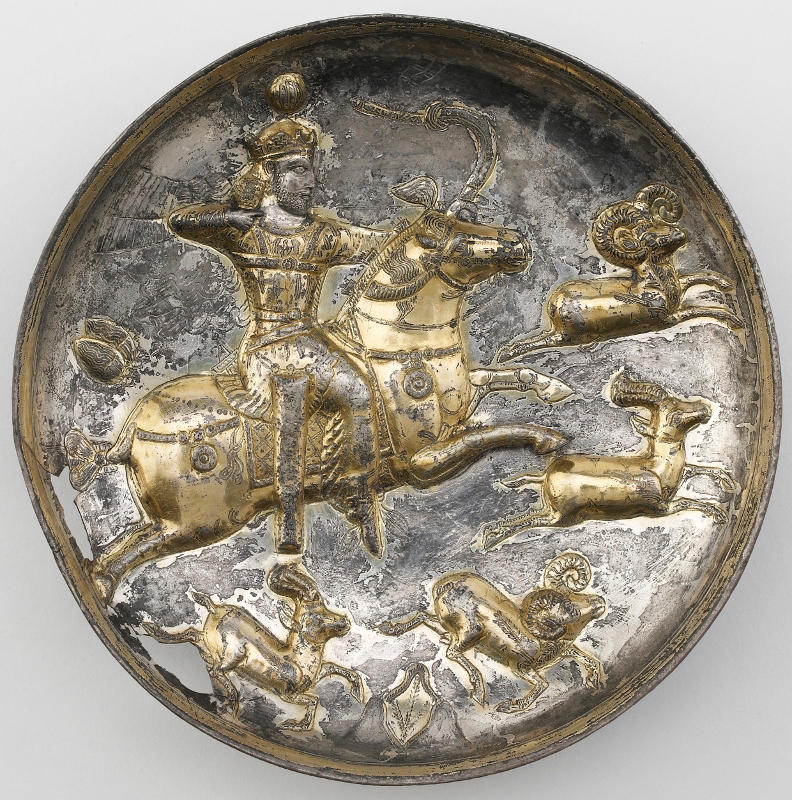Find the perfect fit with Amazon Prime. Try Before You Buy.

Try Amazon Audible Plus
Sasanian Plate with the Shah Hunting Ibex and Gazelle. 4th-5th century.
Freer Gallery of Art F1962.1

A larger image of this Sasanian Plate with the Shah Hunting Ibex and Gazelle. 4th-5th century. Freer Gallery of Art F1962.1.
Bowl
MEDIUM: Silver, partially gilt
DIMENSIONS: H x Diam (overall): 4.9 × 19.1 cm (1 15/16 × 7 1/2 in)
TYPE: Metalwork Vessel
ORIGIN: Iran
DATE: 4th-5th century
PERIOD: Sasanian period
PREVIOUS CUSTODIAN OR OWNER: K. Rabenou
PROVENANCE: To 1962, K. Rabenou, New York, New York.
From 1962, Freer Gallery of Art, purchased from K. Rabenou, New York, New York.
Source: Smithsonian F1962.1
THE PLATE RESTS on a low ring foot. Parts of the decoration are gilded, and a gilded band encircles the interior rim.
On the exterior is a chased line around the circumference, just below the rim.
In the interior in high relief is a royal figure on horseback facing right,
entirely gilded except for face, neck, beard, and hands; with drawn bow he hunts a pair of ibex and a pair of gazelle.
He wears a mural crown with central crescent, surmounted by a vertically striated globe;
there is a beaded band below the crown, and streamers from the diadem flutter to the figure's left.
He wears a tunic and trousers, in paired-line drapery style; over the tunic is a beaded halter tied in back with ribbons that flutter to the left.
His belt is fastened in front. His quiver case, suspended in front, is decorated.
The hilt of his sword is visible to his left.
The horse has a crenelated mane and a saddle blanket decorated with a lozenge pattern.
The horse's right foreleg is cast separately, entirely in the round. The tail is tied with a ribbon.
The quarry is arranged along the lower right and to the right of the mounted hunter;
ibex alternate with gazelle. All four animals are wounded in the shoulder, from which an arrow protrudes.
Just off center, at the base of the tondo, is a tripartite stylized mountain, its center gilded; all "mountains" are ornamented with chased stylized foliage.
The closest comparisons for the hunter's headgear among Sasanian coin representations would be the crowns of the Sasanian king Peroz (r. A.D. 457-84) and the crown of his son Kavad I during his second reign (A.D. 499-531).
Like the Freer Shapur plate [15], this plate belongs to a group of royal hunting plates decorated with scenes of kings wearing crowns closely resembling those depicted on Sasanian coins and rock reliefs.
This plate shares with the group its figural composition and use of the paired-line drapery style.
With a mounted hunter charging to the right in pursuit of four quarry,
the composition is closest to the Peroz-Kavad I plate in the Metropolitan Museum of Art, New York,
and the plate from Ufa, now in the Hermitage Museum, Saint Petersburg.
The rendering of the stumbling ram in the bottom right of the Freer plate is very close to that on the Metropolitan Peroz-Kavad I plate.
On the Ufa plate, the king employs the Parthian shot; like the scene on the Freer plate, the four quarry consist of two pairs of different species, ibex and gazelle.
Details of the horse trappings, however—including the saddle blanket and phalerae—resemble more closely those depicted on the Freer Shapur plate.
The royal figure depicted on this plate [14] also holds the bowstring at the top of the chest and below the hair, as does the hunter on the Freer Shapur plate.
On the Metropolitan Peroz-Kavad I plate, by contrast, the king holds the bow in front of the mass of hair at the neck.
The horse trappings of the Freer plate also resemble those on the plate from Pereshchepina depicting a royal figure hunting rams.
The style of the relief and use of gilding, together with the abbreviated mane of the horse, link this plate with the Cleveland Hormizd plate.
The leaf-shaped ends of the ribbons fastening the royal figure's shoes are unusual.
Among the silver plates depicting royal hunters, only the Metropolitan Yazdgard plate, with a standing royal figure spearing a stag, shares this feature of royal dress.
The Freer plate also exhibits the changes in the iconography of the Sasanian royal hunting plate that were introduced after Peroz,
such as the representation of more than one species of animal among the quarry.
This and other developments are found on plates that portray kings who could be one of many but who are all certainly as late as Kavad I.
A date after the fourth century and not far removed in time from the Metropolitan Peroz-Kavad I plate would seem likely for the Freer plate.
It does not, however, exhibit the same sophisticated artistry of the Freer Shapur plate or the Metropolitan Peroz-Kavad I plate.
Stylized mountains placed at the bottom of the scene also occur on other examples of royal hunting plates and on silver vessels from nonroyal workshops, perhaps beginning as early as the third century.
Source: Plate 14, Ann C. Gunter and Paul Jett Ancient Iranian metalwork in the Arthur M. Sackler Gallery and the Freer Gallery of Art
See also the Sasanian silver-gilt plate from the Synya River. Yazdgard I riding a bull hunting another. 5th to 7th centuries.
Back to Figures on Sasanian and Central Asian Plates


